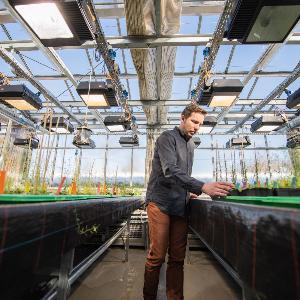Ion transporters in chloroplasts affect the efficacy of photosynthesis
11 May 2021
A study led by LMU plant biologist Hans-Henning Kunz uncovers a new role for ion transporters: they participate in gene regulation in chloroplasts.
11 May 2021
A study led by LMU plant biologist Hans-Henning Kunz uncovers a new role for ion transporters: they participate in gene regulation in chloroplasts.

Prof. Hans-Henning Kunz in the greenhouse. | © LMU
In plants, photosynthesis takes place in intracellular ‘factories’ called chloroplasts. Plant chloroplasts evolved from photosynthetic cyanobacteria, which were engulfed by a non-photosynthetic cell in the course of evolution. As a result of this evolutionary event, chloroplasts possess two envelope membranes, and have retained functional remnants of their original cyanobacterial genomes. Henning Kunz (LMU Biocenter), his group, and their collaborators have now demonstrated that proteins involved in ion transport in the inner chloroplast membrane participate in the regulation of gene expression in the organelle, therefore playing an important role in the control of photosynthesis.
Photosynthesis actually occurs in a highly specialized ‘thylakoid’ membrane system in the chloroplast. This system is encapsulated by the inner and outer envelope. Among the proteins embedded in the inner membrane are ion transporters that regulate the ion balance in the medium, known as the stroma, which bathes the thylakoid membranes in the center of the organelle. It also contains the organelle’s DNA genome, and the ribosomes that synthesize the proteins which it encodes. Notably, photosynthesis is crucially dependent on the coordinated expression of the chloroplast genome and genes that now reside in the cell nucleus. “Using the model plant Arabidopsis thaliana, we have now shown that the ion balance in the stroma plays a role in the exchange of regulatory information between chloroplasts and the nucleus,” says Kunz.
He had previously observed that chloroplast development was delayed and plant growth retarded when two genes that code for specific ion-transport proteins were deleted. “Our experiments show that, in the absence of these ion transporters, certain RNA binding proteins that are encoded by nuclear genes are unable to bind to their target RNAs in the stroma of the chloroplasts,” he explains. As a consequence, the processing and maturation of these RNAs (which are necessary for the transfer of genetic information from the chloroplast genome into stromal proteins) is inhibited. “This defect has a particularly significant effect on RNAs that are required for ribosome assembly in the stroma. The resulting reduction in the numbers of functional ribosomes severely impairs chloroplast protein synthesis in these mutants,” Kunz explains.
The results reported in the new study could contribute to efforts to enhance the efficiency of photosynthesis under otherwise unfavorable environmental conditions, which would help crop plants to adapt to climate change. “Ion transporters could serve as important tools in this context,” says Kunz. “Photosynthetic efficiency is highly dependent on the biochemistry of the stroma. These transport proteins have an important influence on this fine-tuned balance. Only if we start to understand their structures and complex functions in detail it will be possible to manipulate and benefit from the transporters’ action.”
The Plant Cell 2021